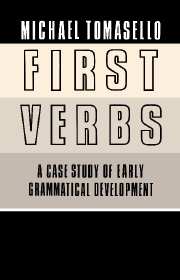Book contents
- Frontmatter
- Contents
- Acknowledgments
- Dedication
- 1 Introduction
- 2 In the beginning was the verb
- 3 Methods and an introduction to T's language
- 4 Change of state verbs and sentences
- 5 Activity verbs and sentences
- 6 Other grammatical structures
- 7 The development of T's verb lexicon
- 8 The development of T's grammar
- 9 Language acquisition as cultural learning
- References
- Appendix
- Index
5 - Activity verbs and sentences
Published online by Cambridge University Press: 18 December 2009
- Frontmatter
- Contents
- Acknowledgments
- Dedication
- 1 Introduction
- 2 In the beginning was the verb
- 3 Methods and an introduction to T's language
- 4 Change of state verbs and sentences
- 5 Activity verbs and sentences
- 6 Other grammatical structures
- 7 The development of T's verb lexicon
- 8 The development of T's grammar
- 9 Language acquisition as cultural learning
- References
- Appendix
- Index
Summary
The change of state verbs analyzed in the previous chapter all refer to situations in which an object or event undergoes some change of state or transformation with well-defined beginning and end points. Formal representation of these words involved depicting the state of the object at an initial “moment of attention” followed by its state at subsequent, including terminal, moments of attention. On the other hand, a second very broad class of verbs involves not the transformations of objects but the actions people and other animate beings perform – actions such as seeing, running, throwing, waving, licking, crying, and loving. These words have as their underlying conceptual situations not object states but bodily or psychological states and motions. Further, although these activities do take place in time, they do not'rely crucially on a well-defined sequence of states with characteristic beginning and end points: Running and seeing have durations but not well-defined initial and final states. In general, when the child “moves” or “gives” something, she is focusing on the object and its transformation, and many different specific actions may effect the change of state; when the child “sees” or “touches” something, she is naming the specific action she is actually performing, and the effect on the object is in the background. These two classes of verbs have been identified and analyzed by a number of linguists (e.g., Foley & van Valin, 1984) as well as some developmental psycholinguists (e.g., Edwards, 1973; Huttenlocher, Smiley, & Charney, 1983).
- Type
- Chapter
- Information
- First VerbsA Case Study of Early Grammatical Development, pp. 114 - 146Publisher: Cambridge University PressPrint publication year: 1992



